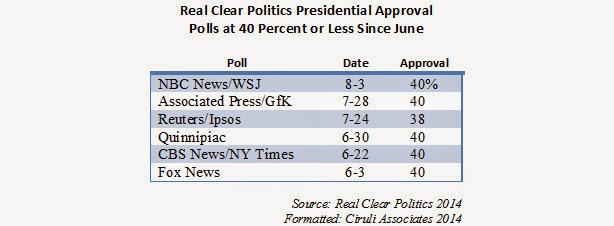In less than three months, voters in Colorado will decide if the Democratic decade continues or if a national Republican wave, compounded by local Democratic overreach, causes it to be reined in. The decision will immediately have implications for the 2016 presidential election.
As of August 10, the averages of polls have the Democratic incumbents, Senator Mark Udall and Governor John Hickenlooper, in tight races, but ahead by a point. But below the top of the ticket, Democratic candidates appear in trouble. If Colorado Republicans can translate the voters’ disenchantment with Democrats’ control of government into an across-the-board protest, they could win control of the state.
As we enter the dog days of summer, major factors affecting this election are:
The Wave
There is considerable debate as to the existence of a national wave of opposition to President Obama and its effect on the election. The current consensus is that there is an effect, but it is “2010 light.” Various measures, such as the generic ballot test, voter enthusiasm and partisan preference, show a Republican advantage, but smaller compared to 2010.
One indication that a Republican advantage exists in Colorado is polls showing Republicans below the “top of the ticket” with a 5- to 10-point across-the-board advantage.
Firewall
Democrats are hoping that Colorado forms a firewall against the Republican wave as it did in 2010. Senator Udall is targeting women with the Democrats’ perennial “war on women” campaign to drive up opponent Rep. Cory Gardner’s negatives and they are mounting a massive and expensive GOTV effort. But Gardner has the benefit of President Obama barely holding onto a 40 percent approval and continued opposition to Obamacare. This election will test if the voters’ decisions can be localized to overcome whatever anti-Washington and anti-Democratic trend exists.
Overreach
Governor Hickenlooper appeared popular and headed to re-election after the 2012 Democratic sweep of the state, but ran into a host of problems in 2013 with Democratic legislative overreach and a death penalty decision that has left him vulnerable. Delaying the fracking fight helped his re-election and he has a reservoir of business friends, including some Republicans, and a strong economy. But, Bob Beauprez got through a Republican primary intact and has an opportunity to benefit from whatever wave develops. Still, Beauprez will likely have to shake up the race to change its trajectory.
Frack or No Frack
Colorado Democrats headed off becoming the first national test in the environmental movement’s attempt to ban fracking and align the Democratic Party with its anti-hydrocarbon wing. The impact of the fracking wars on this year’s Democratic races was assumed to be deleterious. The issue will be around for the 2016 election.
Colorado Purple, Blue or Red?
There is a general sense that if the Republicans can’t win at least one of the top races and take control of one House of the legislature, they will be relegated to long-term minority party status. Colorado is a microcosm of the party’s national problems. It remains on the defensive on a number of social issues and unattractive to some emerging voter groups. A win here will signal that Colorado’s mix of candidates, messaging and GOTV points to a solution. If Democrats survive this year, it reinforces their 2010 model of winning at the local level regardless of the how bad the public believes the party performed at the national level.
Presidential Race and Colorado
The 2016 presidential race has started. Hillary Clinton has already made clear by repeated visits she values Colorado for her 2016 presidential nomination and election. Clearly, a win in 2014 with a Democratic senator and governor will advance her agenda (Bill lost Colorado in 1996 to Bob Dole and she lost the Democratic caucus to Barack Obama in 2008). Conversely, top of the ticket Republican wins will put Colorado in play for 2016.

















